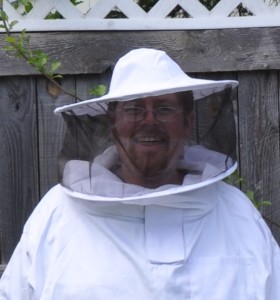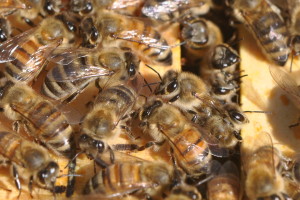Just a Spoonful of Honey…
 Last year, my wife and I began our latest hobby, beekeeping. Over the course of the summer our hives built up from fledgling colonies to robust pollinating and nectar collecting forces. Despite getting our fair share of stings, by August we managed to harvest over 50 pounds of honey. This amount is staggering when you consider that it takes 12 bees their entire lives to produce 1 tsp of honey and that on average bees have to visit 2 million flowers to produce 1 pound of honey. While 50 pounds sound like a lot, if all goes well, we may end up with four times that amount this year. We have enjoyed eating and sharing our honey over the past nine months and have been constantly looking for new ways to use it in cooking. While I think that honey is delicious, as a doctor I have been intrigued by the myriad of benefits it can have on our health as well.
Last year, my wife and I began our latest hobby, beekeeping. Over the course of the summer our hives built up from fledgling colonies to robust pollinating and nectar collecting forces. Despite getting our fair share of stings, by August we managed to harvest over 50 pounds of honey. This amount is staggering when you consider that it takes 12 bees their entire lives to produce 1 tsp of honey and that on average bees have to visit 2 million flowers to produce 1 pound of honey. While 50 pounds sound like a lot, if all goes well, we may end up with four times that amount this year. We have enjoyed eating and sharing our honey over the past nine months and have been constantly looking for new ways to use it in cooking. While I think that honey is delicious, as a doctor I have been intrigued by the myriad of benefits it can have on our health as well.
While the rise in the interest in bees and beekeeping is a relatively new phenomenon, the use of honey as medicine is not. The Egyptians were using honey as medicine more than 4000 years ago and would put some in their burial chambers to take into the afterworld. As a testament to its antimicrobial and antioxidant properties, samples of honey found in Egyptian tombs have been found to be perfectly preserved and still edible.
 One of the prime ways that the Egyptians used honey was for dressing wounds. Honey is still used for wound healing today and studies have backed up its effectiveness. Honey acts a perfect wound dressing since it cleans the wound, acts as an antimicrobial, stimulates tissue regeneration and reduces inflammation. Honey has been found to be useful in in a wide range of wounds including abrasions abscesses, bed sores, ulcers, surgical wounds, and burns.
One of the prime ways that the Egyptians used honey was for dressing wounds. Honey is still used for wound healing today and studies have backed up its effectiveness. Honey acts a perfect wound dressing since it cleans the wound, acts as an antimicrobial, stimulates tissue regeneration and reduces inflammation. Honey has been found to be useful in in a wide range of wounds including abrasions abscesses, bed sores, ulcers, surgical wounds, and burns.
In a time when pharmaceutical antimicrobials are becoming less effective against bacterial infections, honey has shown promise as antimicrobial agent inhibiting the growth of over 60 species of bacteria including MRSA. Unlike conventional antibiotics it does not appear that honey leads to the development of antibiotic resistant strains of bacteria. Honey also does not seem to negatively affect our beneficial gut microbes and has even been shown to increase levels of Lactobacillus and Bifidobacteria.
Honey has other benefits for the gastrointestinal tract in addition to its impact on the microbiota. Honey has been shown to speed the healing of gastric and duodenal ulcers and also to decrease inflammation of the stomach known as gastritis. Use of diluted honey has been found to speed the recovery from cases of infectious diarrhea and gastroenteritis. Taking a teaspoon of honey before meals has been found to decrease the incidence of heart burn or gastro esophageal reflux.
While the idea of pouring honey in your eye may sound strange, eye drops made from hone have been found to be helpful for various ophthalmological conditions including conjunctivitis, blepharitis, dry eyes, keratitis, corneal injuries and even chemical burns.
I typically recommend patients with increased cardiovascular risk and elevated cholesterol avoid sugar, but honey intake may actually decrease cardiovascular risk. When natural honey was compared with artificial honey made of fructose and glucose, the natural honey was found to lower total cholesterol, LDL cholesterol, triglycerides, and CRP, a marker for inflammation. In addition it caused a slight increase in the more beneficial HDL cholesterol. Honey was also found to lower blood pressure and its high antioxidant content may further reduce cardiovascular disease risk.
Coughs in children can lead to sleepless nights for both the child and their parents. A double blind placebo controlled study reported in the journal Pediatrics in 2012 may help give relief to children and their parents. Children with night time coughs caused by an upper respiratory infection given a spoonful of honey before bed decreased coughing and improved sleep. Just keep in mind not to use this remedy in children under 1 year of age as there is a small risk of botulism.
In addition to the properties that I have mentioned that have been studied, numerous anecdotal claims about honey’s healing properties exist. One of the ones that I hear most frequently is the use of local honey to reduce the severity of seasonal allergies. While studies looking at this effect have not been conclusive, my own experience has shown it to be beneficial. When using honey for this use it is important for the honey to be as local as possible so that you are getting exposed to the pollens in your area.
 When buying honey it is important to know that all honey is not the same and that much of what is sold as honey is actually not honey. A study from 2011 found that 75% of what is sold as honey has actually had the pollen filtered out of it. The removal of the pollen appears to decrease the beneficial properties of the honey and definitely decreases it effect on seasonal allergies. When buying honey it is important to remember that you get what you pay for. It was also found that inexpensive “honey” from China was actually honey diluted with high fructose corn syrup.
When buying honey it is important to know that all honey is not the same and that much of what is sold as honey is actually not honey. A study from 2011 found that 75% of what is sold as honey has actually had the pollen filtered out of it. The removal of the pollen appears to decrease the beneficial properties of the honey and definitely decreases it effect on seasonal allergies. When buying honey it is important to remember that you get what you pay for. It was also found that inexpensive “honey” from China was actually honey diluted with high fructose corn syrup.
When you buy honey it is best to buy raw honey and the honey should say on it where it was collected. If you are not able to find local raw honey in your grocery store, try looking at health food stores, farmers markets, or even stores devoted to the sale of honey, bee products and beekeeping supplies like Portland’s The Honey Exchange. Owners Phil and Megan Gavin have a wide selection of local and non-local raw honeys and can tell you about where the honey comes from, what it tastes like and always have a number of delicious honeys available for sample. You can also look inside their observation hive and see the bees in action.
For a refreshing thirst quenching summer time treat try this recipe for a honey rhubarb drink from Poland that combines that tang of rhubarb with the sweet floral taste of honey.

